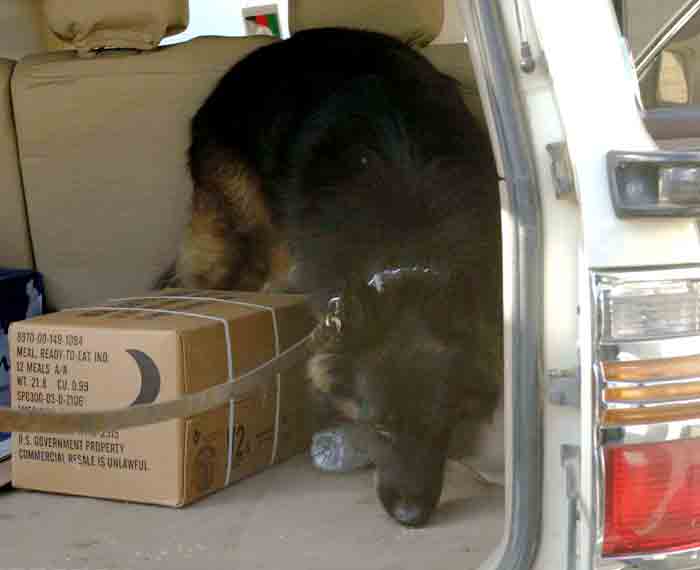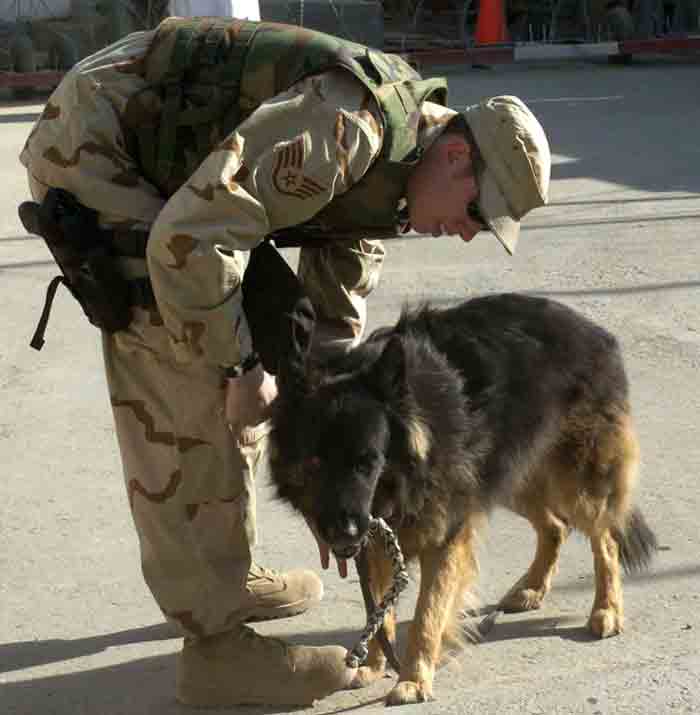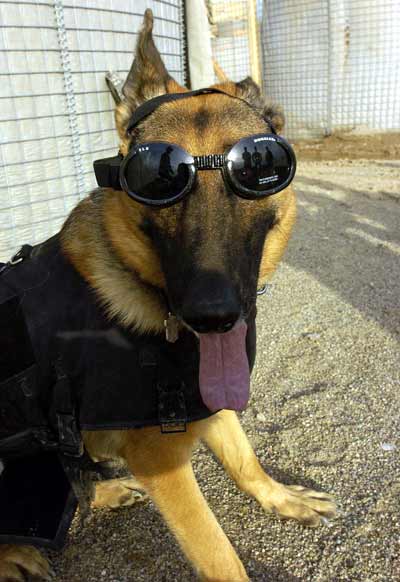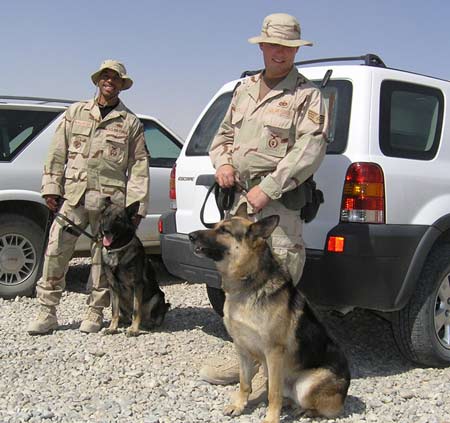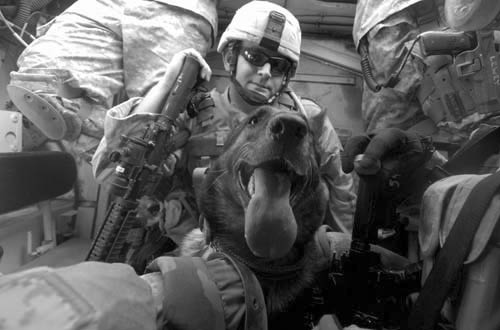11/30/2004 - KABUL COMPOUND,
Afghanistan (AFPN) -- In August, Staff Sgt. David Yepsen had to do
everything all Airmen do when they deploy, from updating training to
getting medically cleared. He also had one more thing to worry about --
his military working dog deploying alongside him. Anywhere from 30 to 60 vehicles
come onto the compound daily and each is searched by a canine team, said
Army Capt. Lorenzo Fiorentino, provost marshal and anti-terrorism force
protection officer here.
“A dog can find things a person can’t,” Sergeant Yepsen said. “A
dog’s nose is probably 1,000 times (more sensitive) than a human’s
nose. So it makes it easier for the dogs to find things that are hidden
that (we) can’t find with the naked eye.”
KABUL COMPOUND, Afghanistan -- Dax, a military working dog, searches the back of a vehicle here. Dax and his handler, Staff Sgt. David Yepsen, are the only Air Force canine team in Afghanistan. They are deployed supporting Operation Enduring Freedom from the 43rd Security Forces Squadron at Pope Air Force Base, N.C. (U.S. Air Force photo by Senior Airman Catharine Schmidt)
KABUL COMPOUND, Afghanistan -- Staff Sgt. David Yepsen rewards his military working dog, Dax, with a toy after Dax found an item Sergeant Yepsen hid in a vehicle for training purposes. The two are the only Air Force canine team in Afghanistan. They are deployed supporting Operation Enduring Freedom from the 43rd Security Forces Squadron at Pope Air Force Base, N.C. (U.S. Air Force photo by Senior Airman Catharine Schmidt)
FOB McHenry benefits from ‘sniff support’ Zeko, an explosive detection canine, takes a breather, after his handler puts his specially made balistic "doggles" on for his daily training at the newly built training course at Forward Operating Base McHenry, Iraq. Spc. Barbara Ospina KIRKUK, Iraq (Army News Service, March 15, 2006) -- With a modified ballistic vest, a Screaming Eagle combat patch and a Combat Action Badge, Zeko still may not look like the average Soldier, but he has become a valuable asset to the troops of Forward Operating Base McHenry.
German shepherd's sniff for trouble
by Tech. Sgt. Paul Dean 9/30/2005 - ALI BASE, Iraq — Ori had a couple of
different handlers while his first one was off the job for a couple of
years. But they’re back together now and sniffing out trouble at one
of the entry check points here. Sergeant McAllister is deployed here from the 1st Security Forces Squadron, Langley Air Force Base, Va. Sergeant Bolton is deployed here from the 509th Security Forces Squadron, Whiteman Air Force Base, Mo. The dogs came from the same place as their handlers. The K-9 teams assigned to the 407th ESFS are integral to securing the base and helping facilitate the successful coalition missions that are undertaken here. Using K-9 teams security forces is able to add an irreplaceable dimension of security to the base. The trained handlers guide their dogs expertly around dozens of vehicles each day as both use their senses to communicate to the other. The Airmen who handle the dogs rely on human training to lead the dogs to areas for inspection; the dogs use heightened and trained scent senses to complete the investigation and communicate any suspicions. The dialogue between handler and dog is unmistakable. Sergeant Bolton has been with Kevin since May 2003 and has mixed feelings about his eventual return to duty at Whiteman. “I should be sewing on (technical sergeant) when I get back. That means my K-9 duty will have to end,” Sergeant Bolton said. Many security forces units transition K-9 handlers into positions with greater responsibility when they’re promoted to E-6. “But I’ve known people who’d rather pass up a promotion and stay with their dog,” Sergeant McAllister said. Sergeant Bolton doubts he would pass up promotion, in which case Kevin will go on to work with another handler. “[The dogs] deal with the changes pretty well,” Sergeant McAllister said. “After a couple of weeks with a new handler — learning how they sound out commands — things are fine.” Ori had a few handlers while Sergeant McAllister was incapacitated, but the getting to know you again phase went smoothly. “He acted a little funny at first, but within a couple of weeks it was as if we were never apart,” Sergeant McAllister said. Regardless of any time apart, the two move around a vehicle as if each is reading the others’ mind. K-9 dogs go to technical school at Lackland Air Force Base, Texas. Training lasts eight to 12 weeks (depending on the dog) according to Sergeants McAllister and Bolton, and then they train with their handler for a couple of weeks before the team is ready to work. “You really develop a bond over time,” Sergeant Bolton said of his K-9 experience. Unfortunately, he doesn’t have the option of taking Kevin with him if he loses his K-9 billet. “The dogs work until they’re 10 or 12, or until they just decide ‘I don’t want to work anymore,’” he said. The dogs transition to new handlers as Airmen move on or until they self-retire. K-9 handlers have preference in the adoption process at the end of a dog’s Air Force career. So as the daily traffic flows onto Ali Base, Ori, Kevin and the other K-9s will keep doing their part to make sure missions can be undertaken successfully.
Ori, a six-year-old German Shepherd, loved the attention he received after a mission in Mosul. In the background is TSgt. Matthew Rebholz, his handler. I have yet to meet a soldier who doesn’t like dogs. Particularly those who sniff out explosives. “I like having them around; they do a great job,” said SFC Mick Stowe as he and several soldiers from 2nd Platoon, B Co., 5th Regiment, 20 Infantry Regiment, began to patrol a street in the Hayaltenak neighborhood in Mosul. The feeling is reciprocated. “We like being here with this guys,” said TSgt. Matthew Rebholz, an Air Force dog handler. “I have a lot of respect for these guys and what they do.The soldiers, however, were more interested in Ori, Rebholz’s six-year-old German Shepherd. “Yeah, it’s great to have a dog out here on these missions,” said SSgt. Kenneth Jones as Ori sniffed through a vehicle. “These dogs can go through a car a lot faster than we can,” he added. And Ori is no run-of-the-mill dog. “I’ve read somewhere that there is about $70,000 invested in a dog like this,” continued Rebholz. On several occasions, mangy and mean dogs approached Ori. And on each occasion, soldiers and Rebholz leveled their weapons on the dog. “I’m not about to let one of these dogs hurt or sicken Ori,” said Rebholz as he holstered his weapon. “I don’t want to have to shoot someone’s dog, but Ori’s too valuable to be injuried,” he added. By the end of the mission, Ori had searched 48 vehicles. “He’s done a good job for us today,” commented Jones. “We’d like to keep him,” he added. |

